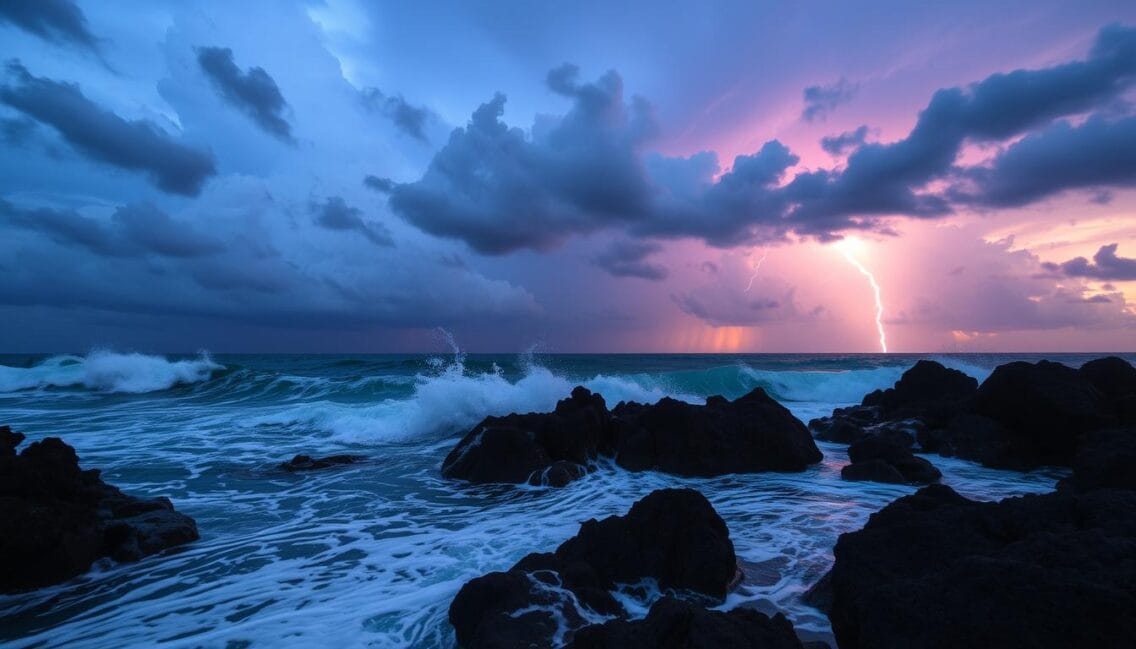My Terrifying Encounter at Sea Manus Jembaton, Indonesia

Imagine being alone in the vast ocean, with only waves and fading light for company. That’s my reality when I sailed from Manus Jembaton, Indonesia. I was an asylum seeker, hoping to find safety and a new start. But the horror was just starting.
The true story I face with sea manus jembaton, indonesia is about desperation and resilience. Asylum seekers like me face danger and uncertainty every day. We hope for a better life, away from violence and oppression.
Looking back, I feel terror and determination. It shows the human spirit’s strength. Even in the toughest times, we keep going.
Key Takeaways
- A personal account of a harrowing encounter at sea as an asylum seeker in Indonesia
- Insight into the global refugee crisis and the challenges faced by those seeking a better life
- Exploration of the resilience and determination required to survive life-threatening situations
- Contextual understanding of the struggles faced by asylum seekers in remote locations
- A glimpse into the human cost of complex political and humanitarian issues
Setting Sail: The Journey That Changed My Life Forever
Standing on the docks, my heart was racing. The weather was bad, with dark clouds and a strong wind. But I couldn’t resist the call of the sea. I wanted to escape the detention centers and human rights violations in this region.
Weather Conditions on Departure Day
The sky was gray, and the waves were rough. They crashed against the boat, making me doubt my choice. But the dream of a better life kept me going. I took a deep breath and stepped aboard, ready for what was to come.
Initial Warning Signs I Should Have Heeded
As we sailed, I felt something was off. The boat sounded old and the engine was weak. But I ignored my fears, thinking the risk was worth it. I didn’t know the tough journey that awaited me.
True story I face with sea manus jembaton, indonesia
As I set sail from Indonesia’s shores, I didn’t know what lay ahead. The offshore processing system was about to become a harsh reality for me. My encounter with Manus Island and Papua New Guinea would change my view forever.
The weather was calm when we left, making me feel safe. But as we went further out, things changed. The waves became wild, and the wind grew stronger, making us all uneasy.
Then, I understood the offshore processing system’s true nature. The link between Manus Island, Papua New Guinea, and asylum seekers’ struggles became clear. The sea’s dangers mirrored the harsh realities in detention centers.
The journey got tougher, both in body and mind. The waves battered the boat, and our future was uncertain. Facing the sea Manus Jembaton, Indonesia, was a scary experience that I’ll never forget.
The Dark Reality of Manus Island’s Detention Centers
Exploring Manus Island’s detention centers revealed harsh truths. Human rights were violated, and asylum seekers faced daily hardships. The conditions were inhumane, with overcrowding, poor medical care, and a lack of basic needs.
Living Conditions in the Facility
Manus Island’s detention centers were overcrowded. Asylum seekers had to share small spaces and limited resources. Poor sanitation and lack of clean water and waste management were major issues.
The asylum seekers had to live in these bad conditions. It made their physical and mental health worse.
Daily Struggles of Asylum Seekers
Asylum seekers in Manus Island faced many daily challenges. The uncertainty of their legal status and long wait for resolution hurt their mental health. This led to depression, anxiety, and self-harm.
They also lacked access to activities and meaningful engagement. This made their emotional situation even harder.
Medical Care Accessibility Issues
Asylum seekers often waited a long time for treatment. The medical resources were not enough to meet their health needs.
This lack of medical care made existing health problems worse. It also led to new physical and mental health issues.
The harsh realities of Manus Island’s detention centers showed the ongoing human rights violations. The bad living conditions, daily struggles, and limited medical care were tough for asylum seekers.
First Signs of Trouble: When the Sea Turned Against Us
Our small boat set sail from Indonesia’s shores, and a true story I face with sea manus jembaton was starting. The weather looked calm, but we soon faced a refugee crisis that tested our survival.
The journey began smoothly, filling us with hope. But as we went deeper, the sea turned against us. Waves crashed hard, and the wind was fierce. It was clear this was no easy sea manus jembaton crossing.
Our hearts were racing with fear and uncertainty. We had to face the unknown, knowing our lives were at risk. The true story I face with sea manus jembaton had turned dangerous. We hoped to find the strength to make it through the treacherous journey.
Surviving the Night: Hours of Uncertainty
As the sun set, our small boat was swallowed by the dark ocean. The coastlines of Australia’s offshore processing facilities disappeared into the distance. A feeling of unease grew in my mind. The waves became more turbulent, and the wind screamed, testing our boat’s strength.
Communication Attempts with Coast Guard
I searched the horizon for help, holding the radio tight. I called the Australia’s immigration policy coast guard, hoping for rescue. But all I got was static, leaving us lost at sea.
Emergency Protocols Implemented
We had to use our emergency plans with little fuel and supplies. We shared what little food we had, hoping our signals would be seen. Each hour felt like an eternity, waiting for rescue that seemed far away.
The night was filled with doubt, but we held on to hope. We believed the dawn would bring us the help we needed.
Face-to-Face with Indonesian Maritime Authorities
Our boat stopped in the rough waters, and the Indonesian patrol vessel loomed. Manus Island, Papua New Guinea, and human rights issues were on my mind. The authorities were coming.
I felt scared as the officers came aboard. Their faces showed nothing. What would they think of our journey? Manus Island and its detention centers were a big worry. I feared they might ignore our human rights.
The officers asked us questions, and I worried about our future. Would they get why we were here, or see us as unwanted asylum seekers? The uncertainty was heavy. I hoped our pleas for help would be heard.
Inside the Refugee Processing System
Asylum seekers face a tough journey through the refugee processing system. They must deal with many rules and a complex interview process. It’s like trying to find your way through a maze.
But, it’s key to understand this system for those looking for a safe place to start anew.
Documentation Requirements
Asylum seekers first need to gather a lot of documents. These include ID, proof of past troubles, and stories of their journey. It’s a hard task, especially for those who had to leave with almost nothing.
Interview Process with Officials
After gathering all the papers, they face the official interview. This is a deep dive into their stories and claims. It’s a high-stakes moment, as one mistake could ruin their chance for asylum.
Despite the hurdles, asylum seekers show incredible strength and will. They’ve faced huge challenges already. With help and determination, they can make it through this tough system and find safety.
The Human Cost of Australia’s Offshore Processing
The refugee crisis is a global challenge. Australia’s immigration policy has been a topic of debate. The country’s offshore processing system has been criticized for its human rights violations.
Detention centers in remote areas have poor living conditions. Asylum seekers face long waits for their cases to be heard. This uncertainty takes a huge toll on their mental health.
Australia’s immigration policy has far-reaching effects. Families are torn apart, and communities suffer. The policy has been widely criticized by human rights groups.
It’s important to remember the human stories behind the numbers. These are not just statistics, but real people whose lives have been changed forever. We need to rethink our approach and focus on the wellbeing of those seeking a better life.
Life in Limbo: Waiting for Resolution
Asylum seekers on Manus Island live in a state of uncertainty and despair. Days blend into weeks, and weeks into months, as they wait for a solution. The mental health effects of this long wait are severe, with many finding it hard to deal with the stress and loneliness.
Mental Health Challenges
The isolation and lack of freedom on Manus Island have severely affected the asylum seekers’ mental health. Depression, anxiety, and PTSD are common, made worse by the lack of professional help. The uncertainty of their future makes things even harder, leaving many feeling hopeless and overwhelmed.
Support Systems Available
Despite the tough situation, there are people and groups trying to help. Organizations like the Asylum Seeker Resource Centre offer medical, mental health, and legal support. But, the resources are limited, struggling to meet the needs of those on Manus Island.
FAQ
What was your terrifying encounter at Sea Manus Jembaton, Indonesia?
My time at Sea Manus Jembaton, Indonesia was terrifying. I was caught in the refugee crisis and faced danger. It changed my life, showing me the struggles of asylum seekers.
What were the weather conditions like on the day you set sail?
The weather looked okay when I started. But, looking back, there were warning signs I missed. The sea got worse, and I realized how dangerous it was.
Can you describe your experience on Manus Island and the detention centers there?
Manus Island’s detention centers were much worse than I thought. Conditions were bad, and medical care was limited. It showed the human rights issues in Australia’s offshore system.
How did you initially react when the sea turned against you?
When the sea got rough, I felt panic and uncertainty. The waves were too much, and I knew it was a fight for survival. Fear of the unknown was overwhelming.
What was it like communicating with the coast guard and implementing emergency protocols?
Trying to call the coast guard was hard, and I felt stuck. We tried to follow emergency plans, but it was chaotic. We hoped to survive the storm.
How did the encounter with the Indonesian maritime authorities unfold?
Meeting the Indonesian authorities was a mix of relief and worry. Their actions showed the complex issues of immigration and human rights. It made me understand the crisis better.
Can you explain the refugee processing system and the challenges faced by asylum seekers?
The refugee system is tough and long. It includes lots of paperwork and interviews. Asylum seekers face many challenges, from meeting requirements to dealing with the emotional toll of detention.
What is the human cost of Australia’s offshore processing policy?
Australia’s policy has a huge human cost. It affects individuals, families, and communities deeply. The mental health issues and the uncertainty are devastating. It has big implications for the region’s refugee crisis.
What were the long-term effects on you and the mental health challenges you faced?
My experience has had lasting effects on my mental health. The trauma and uncertainty have been hard to deal with. The lack of support for those in the system is heartbreaking.



